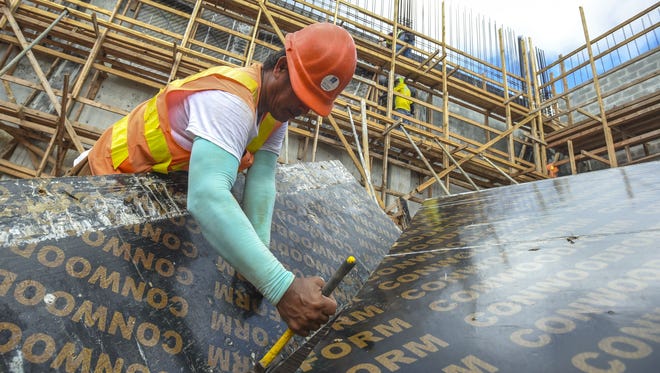‘A lot easier for Guam and the contractors’: Philippines H-2B eligible again
By Anumita Kaur

In this file photo, carpenter Orlando del Mundo removes nails from plywood panels as he and other 5M Construction Corporation employees work at a warehouse building project in Tamuning. The Department of Homeland Security on Wednesday announced the Philippines is once again eligible for H-2B visas. Pacific Marketplace File Photo
The Philippines is once again on the list of countries eligible to participate in the H-2B visa program, the Department of Homeland Security announced Wednesday.
Philippines residents remain ineligible for H-2A visas.
The Philippines was removed in the 2019 list over concerns of severe overstaying and human trafficking, which prompted concern from local contractors, businesses and the government of Guam. Since the 1940s, the vast majority of the island’s foreign workers, mainly in the construction industry, have been from the Philippines.
“What it basically does, with them getting back on the list, it made it a little bit easier, it’s going to make it a little bit faster to actually land workers, and it takes away some of the red tape,” said Greg Massey, Guam Department of Labor administrator. “It’s welcome news, and it was a team Guam effort.”
Homeland Security’s 2021 designation is in effect from Jan. 19, 202, to Jan. 18, 2022, after which federal agency will issue a new list of eligible countries.
The Philippines’ addition to the H-2B eligible list follows passage of the 2021 National Defense Authorization Act, which also expanded Guam’s ability to seek foreign labor for construction projects outside of military fences.
“Since we began office, (Lt. Gov. Josh Tenorio) and I stressed the importance of skilled labor from the Philippines to our growing economy. Even prior to the removal of the Philippines from the H-2B nonimmigrant program in January 2019, Guam had zero approvals for civilian H-2B petitions in 2018 — a significant decrease from a 95% approval prior to 2015,” said Gov. Lou Leon Guerrero. “However, with the help of our federal partners in the Department of Defense and the Department of Interior, as well as the advocacy of Del. (Mike) San Nicolas, the Department of Homeland Security acknowledges the necessity of the Philippine labor force for our growing economy.”
These recent policy updates bode well, according to James Martinez, Guam Contractors Association president.
“That certainly helps the industry a lot,” he said. “To bring back the Philippines is going to make it a lot easier for Guam and the contractors. It’s very different to bring in foreign workers from places as far away as Mexico.”
“Our small contractors are going to have more confidence applying for H-2B workers, knowing Philippines is back on list,” he said.
He estimated there’s nearly a million dollars in local construction backlog on island, along with over $600 million in military projects slated in the coming year.
“We still need to work on growing our own skilled workforce,” he said. “We’re going to need as much help as we can get.”
‘Not a fix all’
Massey agrees.
“The (National Defense Authorization Act) still requires some kind of tie to the buildup. They’ve just stretched that tie a little bit with the new NDAA language,” he said. “It’s not a fix all. But it’s better than the 100% denial we had back in 2016, 2015.
Diversifying Guam’s stream of foreign labor remains important as well, he said.
“Anything can happen, as history has shown. From the Philippines coming off the list, to a pandemic, to who knows what next,” he said. “Having other supply lines from other countries of workers is always going to be a good thing. But the Philippines has traditionally, since the ’40s, we’ve relied heavily on the Philippines, because their citizens integrate well with our workforce. A lot of them have relatives here. It’s a good place for Filipinos to work.”
The latest policies don’t guarantee that all requests for foreign labor from the Philippines will be approved, but it does vastly ease the process.
“So now they would say, I need 30 carpenters, and then they don’t have to come up with names until applying for visas,” Massey said. “When the Philippines was off the list, you had to actually come up with the 30 names before you could ever apply with USCIS, and that’s problematic because it’s a long process. So you’d get a list of names, and these workers would start dropping off, and you’d have to almost start over. It slowed down the process quite a bit.”
As of the beginning of January, 1,502 H-2B workers are on Guam. More than 1,000 applications for H-2B workers are in the pipeline now, all of them from the Philippines.
“Which is kind of normal numbers for us,” he said. “Although the Philippines was put back on the list, we’ve never stopped bringing in workers from the Philippines. It was just a lot harder.”
Source: Pacific Daily News
